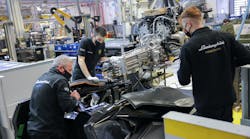So That Happened: Four-Day Work Weeks in Italy, Setting Realistic EV Expectations
Editor’s note: Welcome to So That Happened, our editors’ takes on things going on in the manufacturing world that deserve some extra attention. This will appear regularly in the Member’s Only section of the site.
AI Makes Good Administrative Assistants, Not Floor Operators
I’d like to discuss a pair of reports regarding AI in manufacturing that I read over the past two weeks. In the first report, issued by manufacturing ERP developer Rootstock, 70% of respondents stated they had already implemented some form of AI into their operations. In the second report, issued by tech-based professional services company Sikich, 20% of respondents stated they have no plans to incorporate AI into their operations and more than 60% stated they were either not sure if AI will add any benefit to their companies or they have researched AI but not found an appropriate use case.
What interested me is the point on which both reports agree. The first states that the Top 3 applications for AI in manufacturing are production, employee training and customer service. The second states that the departments benefiting the most currently from AI are marketing (39%), customer service (34%) and factory floor (25%), with supply chain right behind at 23%.
The second report states that when asked about plans for AI, 33% of respondents said customer service applications, 20% said marketing applications and 19% said factory floor. The remaining 28% were unsure. And when the second report measured actual, current AI implementations the respondents reported marketing at 48% and customer service and factory floor tied at 14%.
So now let’s take a break and talk about generative AI, the breakthrough behind this year’s marketing frenzy. The highest-profile deployments for gen AI in 2023 were ChatGPT and Microsoft’s Bing AI integration into the Edge web browser.
In both cases, we’re talking about two primary deployment types. First, using text prompts to get answers from an algorithm on a given topic. The AI trolls the web for information from which to compose answers that from many reports read like lazily written term papers regurgitating facts without adding value like propositions or conclusions.
For marketing departments, employing gen AI to write up quick topic summaries and allow the marketer to focus on selling is invaluable. We’re also talking about advanced chatbots, automated help desk or customer service algorithms meant to sound like humans answering common queries thus avoiding the need to tie a person up on the line.
Does any of that sound like it has anything to do with manufacturing?
The first report breaks down the type of AI respondents were using:
- 60% cited “automation,” that the report defines as “AI-powered software that automates manual processes and administrative work.” There’s our clerical work.
- 37% cited “predictive AI,” defined as “technology that uses statistics, analytics and algorithms to predict upcoming events or outcomes.” Predictive maintenance systems are fairly simple algorithms that depend on the breadth of historical and sensor data, not complex thinking.
- 35% cited “generative AI,” defined as “technology that can produce various types of content, including text, imagery, audio and synthetic data.” There are our marketing department assistants.
- 47% cited “AI-powered industrial IoT,” defined as “systems that monitor manufacturing activity and reduce manual intervention,” and this is where our interest really ought to lie, depending on how much autonomy the system is given to literally run the floor without operators.
As far as I know, manufacturers aren’t willing to remove human beings from the loop yet. Once we can trust AI to run factories as simply as we can trust machine learning to inspect parts, that’s when it’s worth getting excited about AI.
—Dennis Scimeca
Star Charge to Expand Manufacturing to U.S.
EV Charging company Star Charge has announced its new manufacturing facility in the United States will be coming to Columbus, Ohio. The location was chosen due to Ohio’s “favorable business environment, reasonable operational costs, a robust supply chain, and attractive government incentives”.
Production will begin at the plant in the first quarter of 2024 with a planned initial annual capacity of over 20,000 chargers. The facility will produce a range of offerings, including AC, DC, and directional chargers ready for various applications such as residential, commercial fleet, and public service charging as well as NEVI-ready DC fast chargers.
"The US is one of the largest EV markets and is expected to continuously grow over the next decade. Establishing our new facility in Ohio aligns with our commitment and is crucial to our company strategy,” said Herman Chang, CEO of Star Charge.
Since its founding in 2019 in Singapore, Star Charge has deployed more than two million chargers in 60 countries. In addition to the Ohio plant, it has facilities in China and Vietnam.
—Jennifer Ramsay
Refining the Big Potential in Big EVs
Some of the hiccups this year in the growth and adoption of electric vehicles can be traced to the fact—freely and repeatedly stated by the leaders of Ford, General Motors and other incumbent auto names—that many of the guts of EVs are engineered very differently than those of cars and trucks powered by internal combustion. Auburn University’s Samuel Ginn College of Engineering is starting work on its part to fix that when it comes to trucks and transit vehicles.
Auburn trustees recently gave the nod to start work on the $15 million Vehicle Research and Innovation Laboratory, which (with much of its funding coming from the Federal Transit Administration) will look at how to make the next generations of large EVs and the parts that go into them safer and more efficient. It’ll be a while before the lab opens, though: Design work has started but administrators still need to pick its site.
The opportunities for pushing the boundaries in EV trucking and public transit are large. As trucking veteran Michael Roeth recently wrote for our sister brand FleetOwner, industry players complaining that long-haul trucking can’t be sufficiently electrified are overlooking other areas where going electric is a tantalizing proposition.
—Geert De Lombaerde
Holiday Reads for People Who Lead
Still gift-hunting for the hard-to-buy-for engineering-manager-with-CEO-aspirations in your life? Or maybe you’re looking to give your company’s biggest lean enthusiast a boost from the pros? Books from IndustryWeek contributors make excellent last-minute gifts. There’s Shingo-award-winning Learning to Lead, Leading to Learn by Katie Anderson, an engaging look at lessons from Toyota lean sensei Isao Yoshino. Or check out Leading with Grit and Grace, the story of Ashleigh Walters' culture-driven approach to turning around a flagging family-owned manufacturing company in Erie, Pennsylvania, filled with widely resonating leadership lessons. Other stellar picks: How to Do a Gemba Walk by Michael Bremer, Saving American Manufacturing by Michael Collins, Andrew R. Thomas’ supply chain read on the Panama Canal and Mastering the Art of Success by Jack Canfield and IndustryWeek contributor Steven L. Blue.
—Laura Putre
Lamborghini Slashes Workdays, Not Wages
Lamborghini has come to an agreement with unions that will implement a four-day week for production workers. For two-shift departments, workers will have one Friday off every two weeks; for three-shift departments, workers will have two Fridays off every three weeks, creating up to 31 fewer workdays per year.
“The motivation of all the people in the organization is the prime mover of its success because it calls together the best energies and skills of people around a common purpose,” says Umberto Tossini, Automobili Lamborghini’s chief people, culture & organization officer. “Within this framework, the innovative shift system we have developed ensures that we increase the capacity of our plants to be timely in serving the growing number of customers we have around the world. At the same time, the innovations introduced meet people's expectations through working hours that allow everyone to recover the physical and mental energies necessary for communal well-being.”
Lamborghini is part of Volkswagen, the second-largest automaker in the world (behind Toyota), so this new work structure could have a massive impact on global auto production if VW’s other European plants follow suit.
This agreement comes at a time of increasing interest and popularity for the four-day model. From June through December last year, 61 companies and around 2,900 workers in the UK completed a four-day working week trial with no pay reduction. Of those companies, an impressive 92% are continuing with the four-day week, with companies and employees alike reporting satisfaction with the trial outcomes. Similar, although unsuccessful, calls for a 32-hour workweek in the auto industry were heard in the U.S. during the Big Three UAW strike earlier this year.
The draft agreement for the corporate supplementary contract renewal for 2023-2026 also includes a 50% increase in current variable bonuses and an additional bonus of over $1,000 to be paid this December.
—Anna Smith






